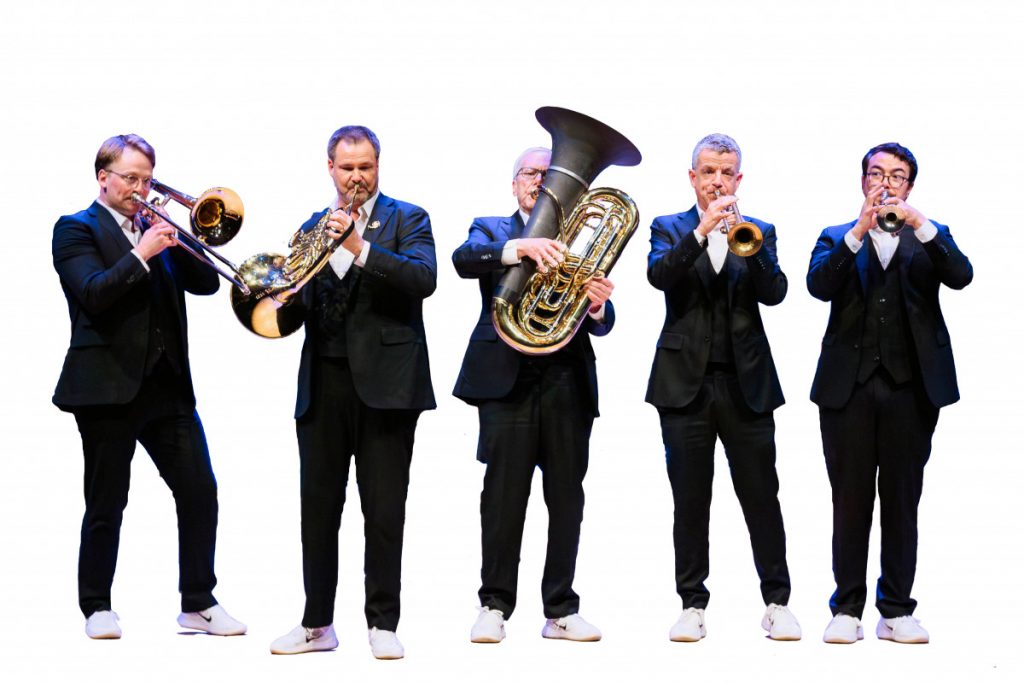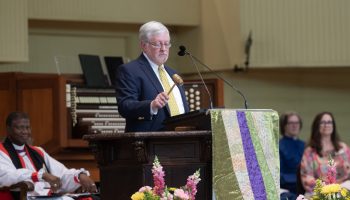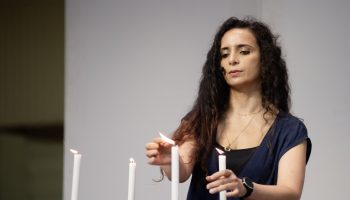
Gabriel Weber
Staff Writer
Grammy-nominated chamber ensemble Canadian Brass performs everything from Vivaldi to Coldplay, and the setlist is ever-evolving.
“Being a musician is not a job — it’s a lifestyle,” said trumpet player Joe Burgstaller.
At 8:15 p.m. tonight, Canadian Brass brings their broad repertoire to the Amphitheater stage.
Created in 1970, Canadian Brass is a pioneer in popularizing brass chamber music. Founding member and tuba player Chuck Daellenbach remains, while trumpet players Burgstaller and Mikio Sasaki, French hornist Jeff Nelsen and trombonist Keith Dyrda joined later on.
“Canadian Brass has led the way in the brass quintet world since its inception and really has been responsible across those 56 years now, almost, for the formation of great music for brass quintet,” Burgstaller said. “So everything you’re going to see in the program comes from that masterwork philosophy.”
The program is an eclectic mix of different styles and composers, all arranged by the ensemble as there aren’t too many pieces written with a brass quintet in mind. They’ll be playing Overture to The Magic Flute K. 620 by Wolfgang Amadeus Mozart; Concerto in D BWV
972 by Antonio Vivaldi and Johann Bach; Chorale Prelude No. 10 by Johannes Brahms; “The Well-Tempered Clavier” by Bach; “Granada” by Agustín Lara; “Eleanor Rigby” by The Beatles; “Viva la Vida” by Coldplay; “Nuevo Tango” by Astor Piazzolla; and excerpts from Bizet’s Carmen.
Since the group chooses which pieces they wish to play, all the works happen to be their favorite, Burgstaller said.
“What we feel ties all this music together is the fact that all this music is reimagined in a way that you haven’t heard before, and that it’s for written for brass quintet,” Dyrda said. “We can take even pop tunes — like the Coldplay that you’ll see on our program — and make these canon for brass. It becomes a standalone thing unto itself; It can work as a brass content piece and something that becomes a staple of our show, as well.”
Burgstaller remembers turning on the TV as a kid and seeing Canadian Brass all over different channels — PBS, “The Tonight Show,” “Sesame Street” and “Entertainment Tonight.”
“The coolest part of our origin stories is that Canadian Brass is part of that,” Burgstaller said. “Thirty years later, joining that very same group that had such a large influence on me starting in trumpet in the first place, is amazing. It’s kind of like we’re a part of our own legacy.”
Burgstaller was introduced to music as an art form with harmonica at age 3; by the time he was 4, he could translate whatever song he heard into a tune on his harmonica. When Burgstaller was introduced to a plethora of instruments in a band room, he picked up the cornet — a smaller version of a trumpet — and never looked back.
“You see that often with children, that a particular instrument immediately resonates with them, and it becomes part of who they are, a part of their voice and the way they express themselves, very deeply and very clearly,” Burgstaller said. “That’s what trumpet and cornet and brass instruments have done for me my entire life.”
Dyrda started playing violin when he was 5 years old and picked up trombone in sixth-grade band. He finds that the slide allows for expression in a way that is close to the human voice and is especially unique.
“Once I picked up the trombone, it was very clear to me that I just had an initial connection to the instrument that was very meaningful for me, and I quickly chose that as my main instrument moving forward. Music has been for me, and the rest of us, this way to connect with your own inner voice and that artistic spirit within,” Dyrda said. “I’ve always found that music brings people together and allows you to become a part of something that’s larger than yourself. What we try to use our shows for is to bring people together and allow music to be a great unifier between people.”
For Dyrda, the role of connection in musicmaking is paramount. A highly in-demand group, Canadian Brass travels all over the globe to reach audiences and is constantly striving to push the boundary of their communicative ability.
“I think it’s really about sort of witnessing the human experience in each other,” Dyrda said. “There’s an interplay on a metaphysical level, and you feel that with the audience, too. My goal when I play is to allow my humanity to come through in the timbre of my sound and the way that I phrase something, that you can’t necessarily pinpoint exactly what it is I’m saying, but people hopefully feel a connection; perhaps I’ve had something to say about the human experience that influences their own life or brings reflection in their humanity.”
Canadian Brass’ cohesion is what ultimately enables listeners to lose themselves in the music.
“Music is magic,” Burgstaller said. “One of the real special things about this group is the intergroup trust and the camaraderie; it’s unlike anything I’ve ever experienced in my career before. … Because of that trust, allowance and flexibility on stage, there’s an alchemy that happens with us that gets presented in an unspoken way to the audience.”
Passionate about education, Canadian Brass hosts masterclasses and has collaborated with El Sistema, the world-renowned music education program originally founded in Venezuela. Teaching is a part of their DNA, Burgstaller said.
“(Education) is a core part of our mission; you can see that in our programming, outreach shows and publishing arm,” Burgstaller said. “There’s a Canadian Brass publication that has a long tradition in placing quality, affordable and reachable music in kids’ worlds. So that is not separate from what we do.”
The group also prioritizes interactions by sitting at the merchandise table after concerts, talking with people and breaking down what Burgstaller calls the fourth wall. Often, they run into the same individuals again and again, as some people have been coming for 50 years; creating relationships, Burgstaller said, has contributed to the longevity of the group.
“The audience is up on the stage with us, in terms of the energy in the room,” Dyrda said. “Even when we’re playing really classical masterworks pieces where it’s very serious music, there’s never a stuffy quality. There’s always an energy in the room where you can clap when you want and support us in whatever way that you feel you want to. We don’t take ourselves too seriously — it’s always in service of the music.”




